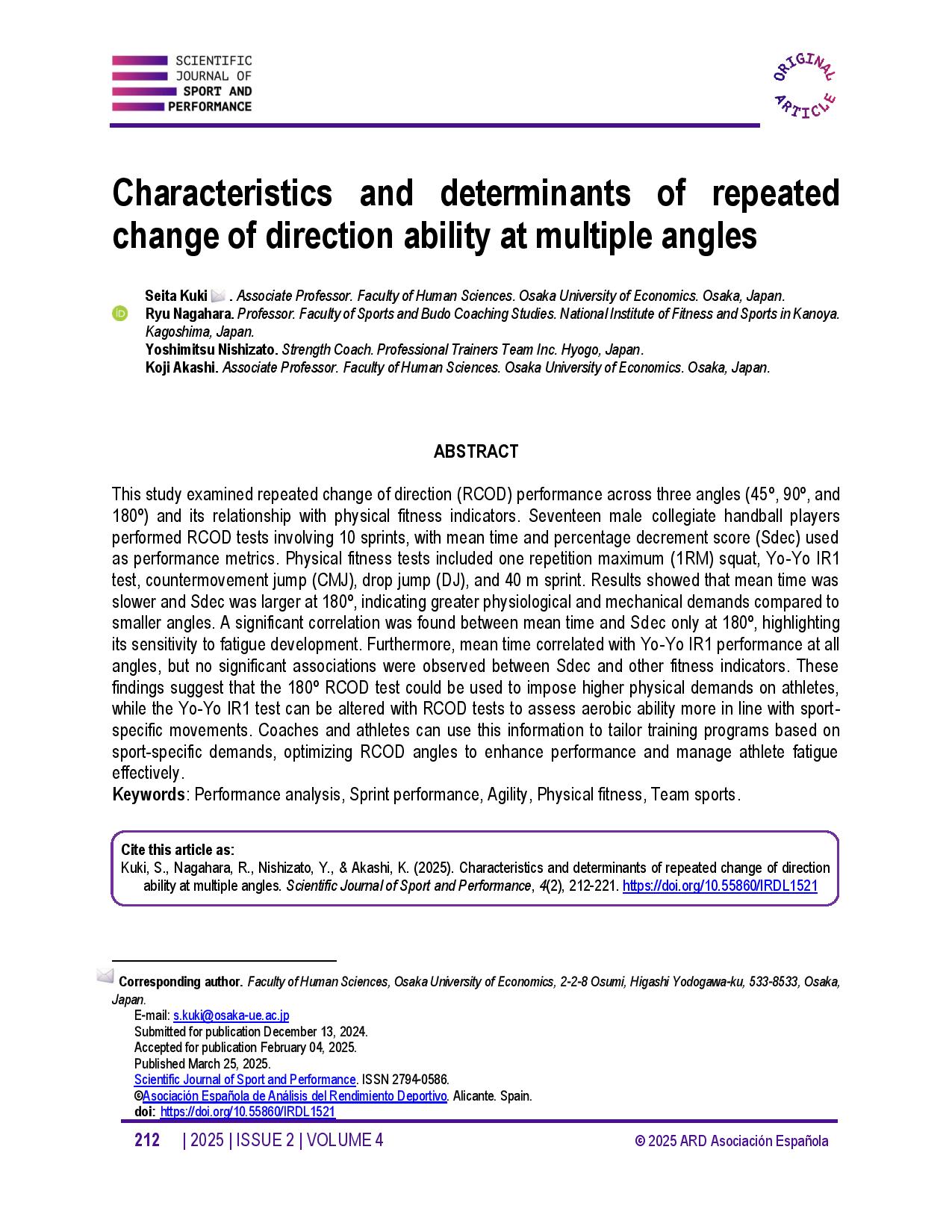Characteristics and determinants of repeated change of direction ability at multiple angles
Main Article Content
Abstract
This study examined repeated change of direction (RCOD) performance across three angles (45º, 90º, and 180º) and its relationship with physical fitness indicators. Seventeen male collegiate handball players performed RCOD tests involving 10 sprints, with mean time and percentage decrement score (Sdec) used as performance metrics. Physical fitness tests included one repetition maximum (1RM) squat, Yo-Yo IR1 test, countermovement jump (CMJ), drop jump (DJ), and 40 m sprint. Results showed that mean time was slower and Sdec was larger at 180º, indicating greater physiological and mechanical demands compared to smaller angles. A significant correlation was found between mean time and Sdec only at 180º, highlighting its sensitivity to fatigue development. Furthermore, mean time correlated with Yo-Yo IR1 performance at all angles, but no significant associations were observed between Sdec and other fitness indicators. These findings suggest that the 180º RCOD test could be used to impose higher physical demands on athletes, while the Yo-Yo IR1 test can be altered with RCOD tests to assess aerobic ability more in line with sport-specific movements. Coaches and athletes can use this information to tailor training programs based on sport-specific demands, optimizing RCOD angles to enhance performance and manage athlete fatigue effectively.
Article Details

This work is licensed under a Creative Commons Attribution-NonCommercial-ShareAlike 4.0 International License.
References
Bangsbo, J. (1994). The physiology of soccer with special reference to intense intermittent exercise. Acta Physiol. Scand., 619, 1-155.
Bogdanis, G. C., Nevill, M. E., Boobis, L. H., & Lakomy, H. K. (1996). Contribution of phosphocreatine and aerobic metabolism to energy supply during repeated sprint exercise. J. Appl. Physiol., 80(3), 876-884. https://doi.org/10.1152/jappl.1996.80.3.876 DOI: https://doi.org/10.1152/jappl.1996.80.3.876
Buchheit, M., Bishop, D., Haydar, B., Nakamura, F. Y., & Ahmaidi, S. (2010). Physiological responses to shuttle repeated-sprint running. Int. J. Sports Med., 31(6), 402-409. https://doi.org/10.1055/s-0030-1249620 DOI: https://doi.org/10.1055/s-0030-1249620
Buchheit, M., Haydar, B., & Ahmaidi, S. (2012). Repeated sprints with directional changes: Do angles matter? J. Sports Sci., 30(6), 555-562. https://doi.org/10.1080/02640414.2012.658079 DOI: https://doi.org/10.1080/02640414.2012.658079
Chavda, S., Bromley, T., Jarvis, P., Williams, S., Bishop, C., & Turner, A. N. (2018). Force-time characteristics of the countermovement jump: Analyzing the curve in Excel. Strength Cond. J., 40(2), 67-77. https://doi.org/10.1519/SSC.0000000000000353 DOI: https://doi.org/10.1519/SSC.0000000000000353
Daneshfar, A., Gahreman, D. E., Koozehchian, M. S., Shalamzari, A. S., Sablouei, M. H., Rosemann, T., & Knechtle, B. (2018). Multi-directional repeated sprint is a valid and reliable test for assessment of junior handball players. Front. Physiol., 9, 317. https://doi.org/10.3389/fphys.2018.00317 DOI: https://doi.org/10.3389/fphys.2018.00317
Gharbi, Z., Dardouri, W., Haj-Sassi, R., Chamari, K., & Souissi, N. (2015). Aerobic and anaerobic determinants of repeated sprint ability in team sports athletes. Biol. Sport, 32(3), 207-212. https://doi.org/10.5604/20831862.1150302 DOI: https://doi.org/10.5604/20831862.1150302
Girard, O., Mendez-Villanueva, A., & Bishop, D. (2011). Repeated-sprint ability - Part I. Sports Med., 41(8), 673-694. https://doi.org/10.2165/11590550-000000000-00000 DOI: https://doi.org/10.2165/11590550-000000000-00000
Glaister, M., Howatson, G., Pattison, J. R., & McInnes, G. (2008). The reliability and validity of fatigue measures during multiple-sprint work: An issue revisited. J. Strength Cond. Res., 22, 1597-1601. https://doi.org/10.1519/JSC.0b013e318181ab80 DOI: https://doi.org/10.1519/JSC.0b013e318181ab80
Hader, K., Mendez-Villanueva, A., Ahmaidi, S., Williams, B. K., & Buchheit, M. (2014). Changes of direction during high-intensity intermittent runs: Neuromuscular and metabolic responses. BMC Sports Sci. Med. Rehabil., 6(1), 1-13. https://doi.org/10.1186/2052-1847-6-2 DOI: https://doi.org/10.1186/2052-1847-6-2
Hopkins, W., Marshall, S., Batterham, A., & Hanin, J. (2009). Progressive statistics for studies in sports medicine and exercise science. Med. Sci. Sports Exerc., 41(1), 3-12. https://doi.org/10.1249/MSS.0b013e31818cb278 DOI: https://doi.org/10.1249/MSS.0b013e31818cb278
McGawley, K., & Bishop, D. (2008). Anaerobic and aerobic contribution to two, 5 × 6-s repeated-sprint bouts. Coach Sport Sci. J., 3, 52. https://doi.org/10.1016/j.jsams.2014.02.002 DOI: https://doi.org/10.1016/j.jsams.2014.02.002
Pyne, D. B., Saunders, P. U., Montgomery, P. G., Hewitt, A. J., & Sheehan, K. (2008). Relationships between repeated sprint testing, speed, and endurance. J. Strength Cond. Res., 22(5), 1633-1637. https://doi.org/10.1519/JSC.0b013e318181fe7a DOI: https://doi.org/10.1519/JSC.0b013e318181fe7a
Rampinini, E., Bishop, D., Marcora, S. M., Bravo, D. F., Sassi, R., & Impellizzeri, F. M. (2007). Validity of simple field tests as indicators of match-related physical performance in top-level professional soccer players. Int. J. Sports Med., 28(3), 228-235. https://doi.org/10.1055/s-2006-924340 DOI: https://doi.org/10.1055/s-2006-924340
Rampinini, E., Sassi, A., Morelli, A., Mazzoni, S., Fanchini, M., & Coutts, A. J. (2009). Repeated sprint ability in professional and amateur soccer players. Appl. Physiol. Nutr. Metab., 34(6), 1048-1054. https://doi.org/10.1139/H09-111 DOI: https://doi.org/10.1139/H09-111
Starczewski, M., Borkowski, L., & Zmijewski, P. (2020). Repeated sprint ability demands in U16 to U19 highly trained handball players concerning playing position. Int. J. Environ. Res. Public Health, 17(16), 5959. https://doi.org/10.3390/ijerph17165959 DOI: https://doi.org/10.3390/ijerph17165959
Stojanovic, M. D., Ostojic, S. M., Calleja-González, J., Milosevic, Z., & Mikic, M. (2012). Correlation between explosive strength, aerobic power and repeated sprint ability in elite basketball players. J. Phys. Fit. Sports Med., 52(4), 375-381.
Wong, D. P., Chan, G. S., & Smith, A. W. (2012). Repeated-sprint and change-of-direction abilities in physically active individuals and soccer players: Training and testing implications. J. Strength Cond. Res., 26(9), 2324-2330. https://doi.org/10.1519/JSC.0b013e31823daeab DOI: https://doi.org/10.1519/JSC.0b013e31823daeab
Young, W. B., McDowell, M. H., & Scarlett, B. J. (2001). Specificity of sprint and agility training methods. J. Strength Cond. Res., 15(3), 315-319. https://doi.org/10.1519/00124278-200108000-00009 DOI: https://doi.org/10.1519/00124278-200108000-00009




